When asked if we’re growing any roses here, my usual response is no. Technically though, that’s not true. We do have roses here at Curbstone Valley. Wild native roses.
Rosa gymnocarpa, also known as the baldhip rose (gymnocarpa means ‘bare fruit’), wood rose, or dwarf wild rose, is native to western North America from British Columbia south to California, and east to Idaho and Montana.
The wood rose is a deciduous arching shrub, generally less than three feet high, that is usually found in mixed open forest. It grows well on slopes, spreading via underground runners, and is useful for erosion control even in poor soils. Here this species prefers some shade, and our more healthy looking specimens are located at the edge of our forested areas, where they have some protection from the late afternoon sun.
This is a very prickly species of rose, and the new growth looks formidable at first glance. The stems are covered with numerous straight prickles. However, the new prickles are quite soft when they first emerge, and this early spring growth is favored by deer.
Not uncommonly, we sight various species of snakes near the base of the plants as they emerge to sun themselves mid-morning, like this Santa Cruz garter snake.
The small, single, fragrant, flowers emerge from May through July, and consist of five petals and five sepals, and are less than 3 cm in diameter.
Flower color ranges from pale lavender to dark pink.
The sepals do not persist on the mature hips, unlike some other wild rose species found in California.
The pear-shaped hips are 6-10 mm across, and persist throughout the winter. The fruits are eaten by various small mammals, birds, and insects.
This species is moderately drought tolerant. Plants in shaded areas here survived our very dry summer last year, although those in more exposed areas, without supplemental irrigation, struggled significantly.
We’ve also noted that some plants in the garden area have some rather spectacular looking galls.
Native American uses for this plant are numerous. A poultice of chewed leaves was applied to bee stings by the Okanagan. Pomo and Kashaya tribes used the fresh fruits as food. The Thompson used a decoction of the bark as an eye-wash, and made a tea from the young leaves and stems. The fruits were rarely eaten. The woody stems were used to craft hoops for baby-carriers, and to make arrows. Children strung the hips together and used them as beads. Okanagan-Colville, and Thompson tribes used large branches to sweep the area of the graves before burial to remove any evil influences. [1]
If you’re fortunate to have this rose growing in your garden, it can apparently be most successfully propagated by transplanting new sucker growth, and then leaving the transplant undisturbed. Otherwise some nurseries specializing in California natives do occasionally stock this species.
——————
[1] Daniel E. Moerman’s Native American Ethnobotanical Database


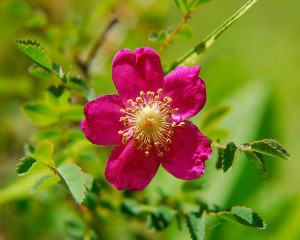
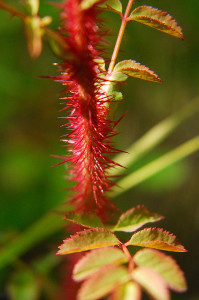
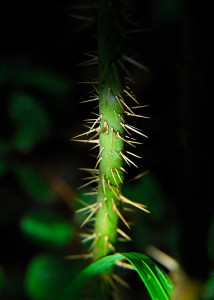
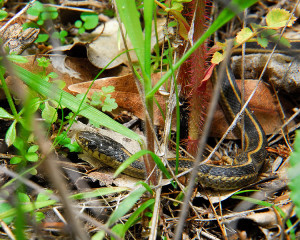
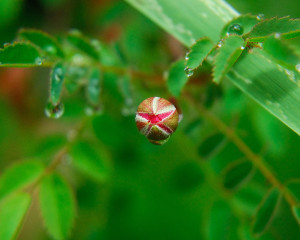
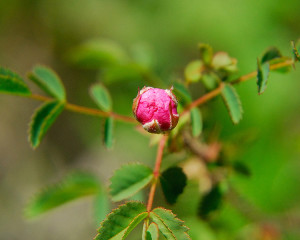
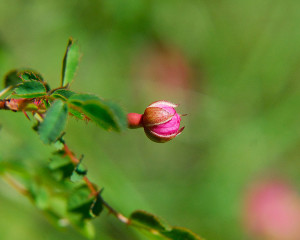
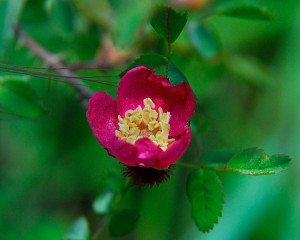
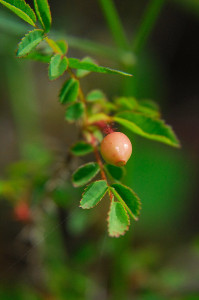
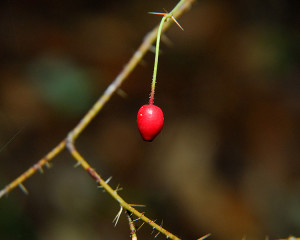
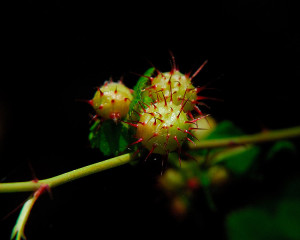
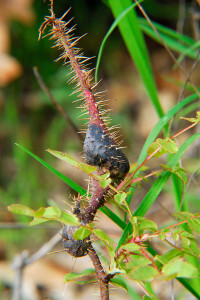
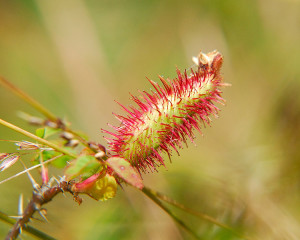
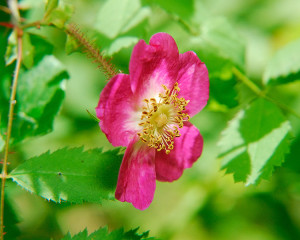







That rose is very pretty and I love your photos.
I hope I don’t run into any snakes…:/ My boys had a garter snake for about two days and I made them let him go. I’m not sure who was happier…me or the snake.
.-= Amy/goawayimgardening!´s last blog ..Rabbit, Dog and A Gardener =-.
When you first described the thorns, I was thinking this rose has a good defense against the deer. Then I read the next sentence — oh, well! I am always amazed at how resourceful the native Americans were and how they often found uses for every part of a plant. Your native rose is pretty and has an interesting history, too.
.-= debsgarden´s last blog ..A Hummingbird In My Garden =-.
Those really look like they would hurt. The flowers are quite lovely, though. Now, I’m not a fan of roses, because I’m not a fan of their foliage. Is the foliage of these similar to what one would consider a standard type rose?
It is quite similar, although the leaves are very small. However, as it’s a wild rose, it’s very hardy. Here at least, I’ve never seen the typical rust, or blackspot diseases that so commonly afflict more modern hybrid species.
What a pretty little rose. They look like the ones I’ve seen growing in the “wild” around here. I was surprised to find that some roses were native, always thinking of them as something that was introduced from somewhere else. The little hips do look like they’d be perfect to string together as beads.
.-= Catherine´s last blog ..May end of month view. =-.
I LOVE species roses and this one is no exception! I love the color. You should do something with the hips, like make tea or preserves. I put in two Rosa rugosas specifically for their hips.
.-= Dog Island Farm´s last blog ..flickr of inspiration- bbq grills =-.
Hi Clare its flower looks so similar to our native hedgerow Rosa Canina in the UK. At first when I saw the photo of those vicious red thorns I thought it would be a thug but its not really if the deer find the new growth so attractive to munch on. I’m quite amazed that the thorns at that stage are soft to touch.
We have quite a few dogwood roses growing along the lade but I’ve never taken much notice of them – I will from now on and try and see if they have some similar characteristics to yours.
.-= Rosie@leavesnbloom´s last blog ..Jewellery showcase in the Garden =-.
Love that picture with the new thorns and coloured leaves, just gorgeous!
.-= Deborah at Kilbourne Grove´s last blog ..Daybreak =-.
How lucky for you to have such a beautiful native rose growing on your property. The fruits too are lovely, and what a pretty leaf gall! Interesting plant.
.-= Floridagirl´s last blog ..Peace at the River =-.
Isn’t that leaf gall wild? I’m wondering with as many galls as I’m finding on these plants who is responsible. Perhaps a parasitic wasp of some sort?
I love this rose! It was so abundant and beautiful in Yosemite, and I see quite a few when I’m out hiking. Why haven’t I planted it? Well, truth be told, I’m a little worried it will take over…And I think that’s why they’re so hard to find in the trade. They do — spread.
Here we seem to have fairly discrete small shrubs. It doesn’t seem to form the really dense thickets like Rosa nutkana, or Rosa californica. The shrubs seem more open, and the tallest here are maybe 4 feet. I did see yesterday that Yerba Buena Nursery is currently stocking it at $12.00 for a 1 gallon plant. In the garden though, it’s not a profuse bloomer by any stretch, but for a volunteer plant, I rather like it.
As always, a lovely post, Clare. Your wild Rosa gymnocarpa is most charming. June is rose month here in Michigan also although mine are most simple … like the now blooming Carefree Beauty Shrub rose that I love.
.-= joey´s last blog ..‘EPITOME OF JUNE’ ~ PEONY (Paeonia) =-.
I just saw some hiking the other day. I pointed it out to a friend and she was surprised it was a rose, since she was used to the larger petal heavy garden/florist varieties. They are quite small. I think you can use the hips for tea, like other roses, but don’t quote me on that.
.-= Brad´s last blog ..Stop – Don’t do this! Invasives =-.
Prickly, indeed! Beautiful, though. I especially like the macro shots of the little bud. Very nice!
.-= Kimberly´s last blog ..Take a Hike! at Oak Hammock Park =-.
Oh my – this should be wordless Wednesday for comments. Suffice it to say how very beautiful your images are and the wildlife you’ve captured. That rose would make a good anti-intruder boundary hedge – or is that something only urban gardeners have to consider?!
thank you for sharing these – I’m so envious
Laura
.-= PatioPatch´s last blog ..Lawn Re-design: Baby’s Tears & Tantrums =-.
Though I live near its range, I’m actually unfamiliar with this rose – we have R. californica in my area (alsmost as prickly, and the hips are prickly, too). Thanks for this nice photographic illustration of the various stages. I also appreciate the introduction to that database, which sounds like a good one.
.-= Pomona Belvedere´s last blog ..Wild Buttercups (Ranunculus occidentalis) =-.
Hello Clare, now this looks like the hardy sort of rose that I should be growing! I love the intense shade of the flower in the example you have photographed!
.-= Heidi (GippyGardener)´s last blog ..Cheer Up Charlie! =-.